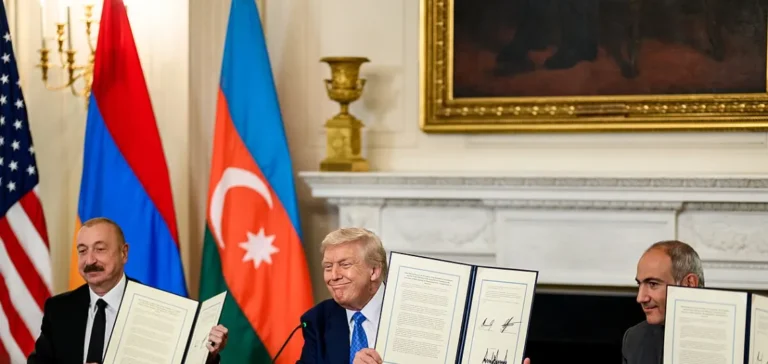Azerbaijan and Armenia have signed a historic agreement at the White House granting the United States exclusive development rights for 99 years to the Zangezur corridor, renamed the Trump Route for International Peace and Prosperity (TRIPP). This 43-kilometer infrastructure crossing Armenia’s Syunik province will connect mainland Azerbaijan to its Nakhchivan enclave, located 32 kilometers away and bordering Turkey. The selected American consortium will develop railway lines, oil pipelines, gas pipelines, fiber optic cables, and potentially electric transmission lines. The agreement comes after 37 years of conflict over Nagorno-Karabakh and four years of intensive negotiations since the 2020 war that saw Azerbaijan regain control of significant territories.
A Complex Legal Framework for Energy Transit
The corridor will operate under Armenian jurisdiction according to the terms of the agreement, but the United States will hold exclusive development rights and sublease operations to selected private operators. This hybrid legal structure requires harmonization of three distinct regulatory frameworks: Armenian law for territorial sovereignty, American law for development contracts, and international standards for energy transit. The agreement stipulates that Armenia retains customs and security control while guaranteeing unimpeded passage for Azerbaijani goods. Arbitration provisions provide for recourse to the Permanent Court of Arbitration in The Hague in case of disputes between parties.
The American International Development Finance Corporation (DFC) has allocated $500 million in initial financing with loan guarantees of up to $5 billion, conditional on compliance with strict environmental and social standards. The selected consortium must comply with Organisation for Economic Co-operation and Development (OECD) standards for cross-border infrastructure projects. The European Bank for Reconstruction and Development (EBRD) is considering $1.5 billion in participation, subject to the project’s alignment with European climate objectives. Transit contracts must comply with World Trade Organization (WTO) rules regarding free passage of goods.
Constitutional and Diplomatic Conditions of the Agreement
Azerbaijan demands that Armenia modify its constitution to remove Article 13 referring to the 1990 declaration of independence that mentions unification with Nagorno-Karabakh. This constitutional modification will require a national referendum that Prime Minister Nikol Pashinyan must organize before the June 2026 parliamentary elections. The Armenian referendum process requires a qualified majority of 60% of voters and a minimum turnout of 50% to validate constitutional amendments. The Organization for Security and Co-operation in Europe (OSCE) has offered to send observers to supervise the referendum process.
The agreement also provides for the dissolution of the OSCE Minsk Group, a mediation mechanism established in 1992 and co-chaired by France, the United States, and Russia. This dissolution requires formal approval from the 57 OSCE member states at the next ministerial meeting in December 2025. European Union monitoring missions currently deployed along the Armenian-Azerbaijani border must be withdrawn according to the terms of the agreement. The withdrawal of 3,500 Russian border guards stationed at the Armenian-Iranian border must be coordinated with the deployment of Armenian forces trained to NATO standards.
Regulatory Implications for the Energy Sector
The Trans-Caspian International Transport Route (TITR) must be adapted to integrate the TRIPP corridor into the existing Middle Corridor regulatory framework. Gas operators will need to negotiate new transit agreements compliant with European directives on Third Party Access to networks. The State Oil Company of Azerbaijan Republic (SOCAR) plans to increase its production from 35 to 45 billion cubic meters by 2030, requiring new operating licenses from the Azerbaijani Ministry of Energy. Long-term supply contracts with European buyers will need to be renegotiated to integrate the new transit routes.
The European Commission will need to revise its regulatory framework for the Southern Gas Corridor to accommodate additional volumes transiting through the TRIPP corridor. The 10 billion cubic meters currently transported via the Trans Anatolian Pipeline (TANAP) and the Trans Adriatic Pipeline (TAP) could double by 2035. Operators must obtain environmental compliance certifications for each pipeline segment according to European Directive 2011/92/EU on environmental impact assessment. Transit tariffs will be regulated by a tripartite mechanism involving Armenian, Azerbaijani, and American regulators.
Legal and Diplomatic Obstacles to Overcome
Iran has threatened to invoke the Treaty of Friendship, Cooperation and Mutual Security signed with Armenia in 1992 to block the project. Tehran could appeal to the International Court of Justice arguing that the corridor violates the principle of territorial sovereignty and threatens regional security. Iranian authorities have announced military exercises involving 50,000 soldiers in border provinces, invoking their right to preventive self-defense under Article 51 of the United Nations Charter. The Iranian Ministry of Foreign Affairs has summoned the Armenian ambassador to express its “serious concerns” about the American presence near its borders.
Russia contests the legality of transferring corridor control without prior consultation with the 2020 ceasefire guarantors. Moscow invokes the November 9, 2020 trilateral agreement that provided for Russian control of communication routes between Azerbaijan and Nakhchivan. The Russian Ministry of Foreign Affairs has stated that any unilateral change to regional security arrangements requires approval from all signatory parties. Russian lawyers are studying the possibility of challenging the agreement before international bodies, arguing that it violates principles of international law concerning pre-existing treaty obligations.
Regulatory Timeline and Implementation Stages
Formal negotiations for selecting the operating consortium will begin next week with nine pre-qualified candidates, including three American companies. The bidding process will follow American Federal Acquisition Regulation procedures with a 90-day due diligence phase. Bidders must demonstrate minimum financial capacity of $2 billion and experience managing cross-border infrastructure. Final award will require approval from the Committee on Foreign Investment in the United States (CFIUS) for national security aspects.
Construction will begin in the first quarter of 2026 after obtaining all required environmental and regulatory authorizations. Construction permits must be issued by Armenian authorities for each corridor segment crossing Syunik municipalities. The cross-border environmental impact assessment will take 12 months according to Espoo Convention standards on environmental impact assessment. The $4.2 billion railway works will span 36 months with quarterly compliance audits by independent international inspectors.
The TRIPP corridor therefore represents a major regulatory challenge requiring harmonization of multiple national and international legal frameworks. Investors will need to navigate a complex legal environment marked by diplomatic opposition and constitutional uncertainties. The project’s success will depend on the parties’ ability to meet their regulatory commitments while managing potential legal challenges from Iran and Russia. The implications for the European energy regulatory framework are substantial, requiring significant adaptations to accommodate this new transit route estimated at over $10 billion in investments.






















